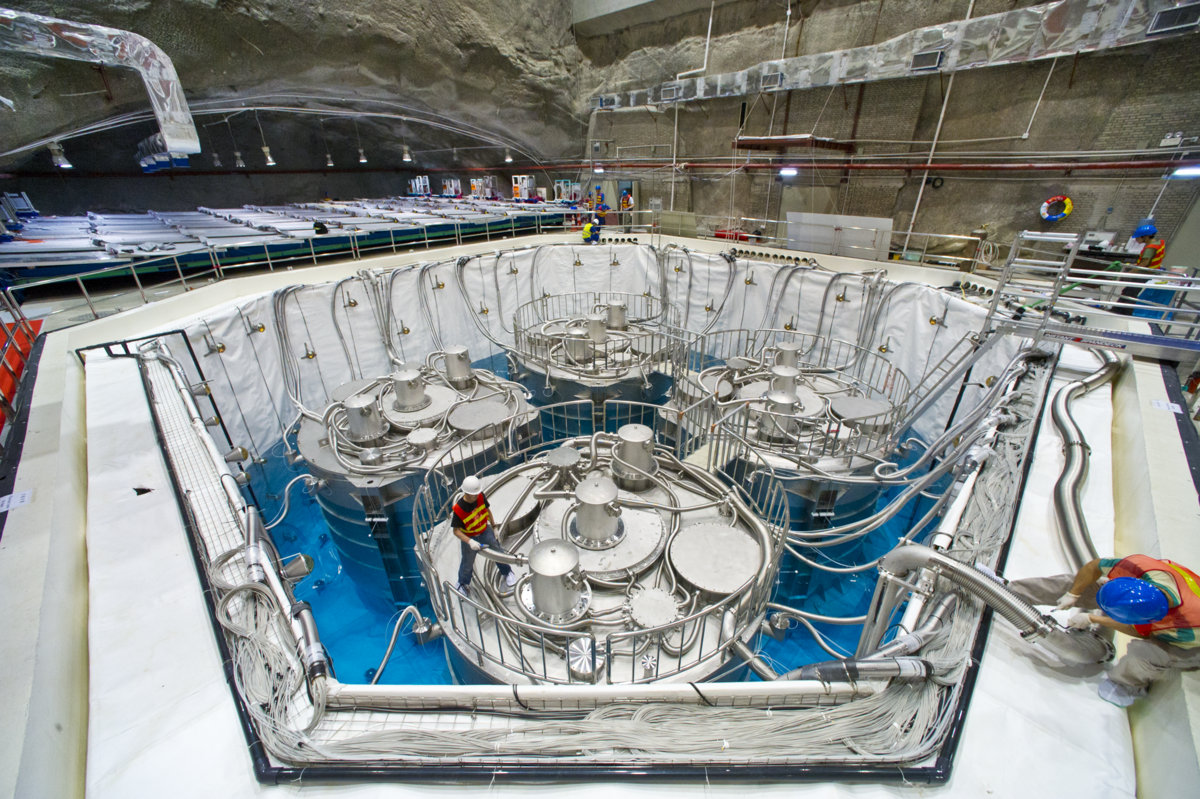
Antineutrino detectors are submersed in liquid at the Daya Bay experiment, as seen during the final phase of construction in August 2012. (Credit: Roy Kaltschmidt/Berkeley Lab)
Experiment: Daya Bay reactor neutrino experiment
About: The Daya Bay reactor neutrino experiment is designed to measure the properties of ghostly particles called neutrinos, and more specifically reactor-produced antineutrinos.
Location: Daya Bay Nuclear Power Plant complex, Shenzen, China.
Role: Berkeley Lab’s Kam-Biu Luk, co-spokesperson for the Daya Bay experiment, leads U.S. participation in the experiment.
Website: http://dayabay.ihep.ac.cn/
Note: This is part of a recurring series highlighting ongoing Berkeley Lab work in international physics collaborations during the COVID-19 pandemic.
Largely unaffected by the pandemic, the Daya Bay reactor neutrino experiment in Shenzen, China, has continued to pump data to remote supercomputers for analyses.
“Since 2017, we have instituted remote shifts so that members don’t have to travel to Daya Bay for babysitting the operation of the experiment,” said Kam-Biu Luk, a co-spokesperson for the Daya Bay collaboration who is a faculty senior scientist at Berkeley Lab and a physics professor at UC Berkeley.
“We can monitor the health of the experiment even with a cell phone. As a matter of fact, I have stopped and checked the status of the experiment with my iPhone while I was getting groceries with my wife,” he added.
See other articles in this series:
• Some Lab Magnet Work Proceeds on Particle Accelerator Upgrade
• In International Physics Collaborations, Working Remotely Is Nothing New
• Site of LUX-ZEPLIN Dark Matter Search Project Carefully Ramps Up Science Work
• CUORE Underground Experiment in Italy Carries on Despite Pandemic
• DESI Team Prepares for Telescope Instrument’s Restart after Unexpected Shutdown
The experiment, which first launched in 2011, is designed to capture signals for nuclear reactor-produced particles known as antineutrinos that are detected by sensors in liquid-filled tanks.
Its goal is to provide new insight about the neutrino properties – neutrinos can switch among three known varieties, known as flavors, for example, and can pass through most matter unchanged and uninterrupted. And the experiment has already contributed new findings about neutrinos.
The Daya Bay international collaboration involves more than 200 researchers at about 40 institutions in Asia, Europe, and the U.S., and Luk noted that the collaboration is fortunate in its existing capacity for remote work. “We are used to holding meetings remotely across different time zones,” he said. “As a result, life is as usual in this regard.”
While the absence of face-to-face discussions is a downside during this time of widespread shelter-in-place orders, Luk said that without daily car commuting to the office there is now more time to spend on the science of the experiment.
“Many of us now can focus on computing activities and data analysis with less distraction,” he said. “Considering how disruptive this COVID-19 pandemic is to societies, it is kind of a miracle that we haven’t been negatively impacted in the data movement.”
More:
- New Measurements Suggest ‘Antineutrino Anomaly’ Fueled by Modeling Error, April 5, 2017
- Best Precision Yet for Neutrino Measurements at Daya Bay, Sept. 11, 2015
- Announcing the First Results from Daya Bay: Discovery of a New Kind of Neutrino Transformation, March 7, 2012
###
Founded in 1931 on the belief that the biggest scientific challenges are best addressed by teams, Lawrence Berkeley National Laboratory and its scientists have been recognized with 13 Nobel Prizes. Today, Berkeley Lab researchers develop sustainable energy and environmental solutions, create useful new materials, advance the frontiers of computing, and probe the mysteries of life, matter, and the universe. Scientists from around the world rely on the Lab’s facilities for their own discovery science. Berkeley Lab is a multiprogram national laboratory, managed by the University of California for the U.S. Department of Energy’s Office of Science.
DOE’s Office of Science is the single largest supporter of basic research in the physical sciences in the United States, and is working to address some of the most pressing challenges of our time. For more information, please visit energy.gov/science.